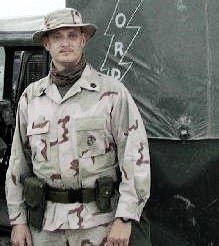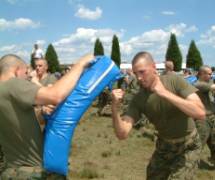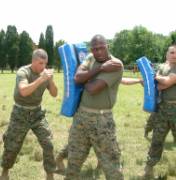The Martialist thanks its paid sponsors, whose products you need!
| Home |
| Intro |
| Current Issue |
| Store |
| Strength |
| Subscriber Content |
| Archives |
| Martialism |
| Pacifism |
| Q & A |
| Cunning-Hammery |
| Advertise With Us |
|
Submit An Article |
| Staff |
|
Combatives Forum |
|
Self Defense Forum |
| Links |
“Stay ‘unreasonable.’ If you don’t like the solutions
[available to you], come up with your own.”
Dan Webre
The Martialist does not constitute legal
advice. It is for ENTERTAINMENT PURPOSES ONLY.
Copyright © 2003 Phil Elmore, all rights reserved.
The Reality of Combat
By Kosta
Moutzouris
 Self-defense
Self-defense
is often cited as the primary reason why many practitioners enter into the
martial arts. Do you ask yourself, “Am I training to be able to defend myself
and possibly even save my life?” Instructors are quick to take advantage of
this in their marketing of the training they are offering. In an attempt to
examine realistic combat and surviving a violent confrontation, I have
interviewed a series of individuals who have prepared to deal with combat
situations and have experienced violence.
Leading among these individuals are
military personnel. Soldiers are trained for the objective of violently taking
control of territory and surviving. Their profession involves being able to
perform regardless of the stress and turmoil going on around them. The
following interview is with David Craik, who has been serving in the United
States Marine Corps for 16 years. Currently a Gunnery Sergeant, he has been
involved in combat operations in Bosnia, Somalia, Afghanistan, and Iraq, as
well as antiterrorist and security operations in the Philippines and Kuwait.
His military training includes Jungle Environment Survival Training held in
the Philippines and Desert Environment Survival Training in Yuma, AZ.
Gunnery Sergeant Craik has
extensive training in the martial arts as well, including Wado-Ryu Karate,
Tae
Kwon Do, the Marine Corps Martial Arts Program, L.I.N.E., Muso-Jikiden Eishin
Ryu Iaido, and boxing. He has trained informally with many other martial artists
of different styles. His views are presented here concerning a variety of
topics revolving around combat and pragmatic self-defense.
NOTE:
The views expressed here are exclusively those of David Craik
and do not represent the United States Marine Corps or the Department of
Defense.
Intelligently
anticipating a violent encounter is perhaps the most important step to being
able to deal with such an encounter if it arises. When asked to describe
some experiences that he feels could correlate those in a military operation
to those a civilian may encounter in a self-defense situation, Gunnery
Sergeant Craik
feels they are fairly cut and dried, as he has been attacked off duty as well.
“I think the main difference is that in combat you usually know when the
fight is going to begin. It’s a situation in which there’s little you can do
to ‘fight’ the enemy directly or the shit has already hit the fan and there’s
little time to think,” says Craik. With that, he offers these key points:
Fear of the Unknown
“Prior
to Operation Iraqi Freedom, everyone knew it was coming. Not the precise date
at my level, but we knew we didn’t get ‘all dressed up for nothin’.’
Thoughts turned to friends and family back home; some were afraid, some not.
We weren’t sure what was going to happen once the war began, but the fear was
not the sudden terror of an attempted mugging or rape just a quiet and not at
all overwhelming uneasiness. We knew we could trust our training, and it was
that which we would turn to when it began. Despite this, everyone was
motivated and in good spirits. The sooner it begins, the sooner it would all
be over and we could go home.”
Impotence
“This
is the weirdest and most frustrating type of feeling. An example would be when
the incoming missile alarm goes off as in Desert Storm and O.I.F., and you
know there is no way to fight back. How do you ‘fight’ a missile,
bomb, or artillery shell? All you can do is once again fall back on your
training. Don your gas mask, give the visual and verbal signal to those around
you, don the rest of your protective suit, helmet, flak jacket, make sure the
Marines around you have done the same and are headed to the bunker, then head
there yourself and wait. This was weird for me because each time I was not so
much afraid as amazed it was happening. Every NBC (Nuclear, Biological, and
Chemical) instructor I ever had was there in my head talking to me. It is
funny that the things you sometimes forget to do in practice are done textbook
fashion when it’s for real.”
Sudden Fear
“When
an attack comes unexpectedly in combat, it is the same as for a civilian,
except usually on a larger scale. The same effects: tachypsychia (the
perceived slowing of time), tunnel vision, adrenaline/endorphin dump, loss of
fine motor skills, and auditory exclusion (can’t remember hearing the actual
shots or shouted commands afterward) seem universal to the soldier or Marine,
police officer, or civilian. Important considerations to apply to one’s
training in order to ensure effectiveness should include pushing one’s limits
and realistic scenarios. Both should be integrated into drills.”
 Looking
Looking
at what he feels should be of primary importance, Gunnery Sergeant Craik says this:
“I feel that it is very important to periodically test your limits and to
train in a manner which is as realistic as possible while still keeping safety
foremost. All the same, coming mainly from a traditional Japanese and Korean
MA background, I am also of the opinion that MA training conducted in a dojo
while wearing dogi, utilizing kata, and traditional training methods is
invaluable to those who train in such a style.
“I feel that the bulk of one’s
training should come from practice in the dojo under a competent instructor.
It is only when one has a firm grasp of the basics and principles of a system
that one should seek to challenge oneself further, experimenting and applying
the principles of one’s system in different conditions and environments.”
Some examples to supplement one’s regular training include what is known as
“Bull in the Ring”, Craik elaborates. “This is something we do in
the Marine Corps Martial Art Program. It really drives home the need for good
technique, and the more people you have, the better. Form a circle with your
dojo-mates or fellow students and designate a person to stand in the center in
his normal fighting stance. A technique requiring quite a bit of skill is
chosen. We use a type of sweep that requires that the opponent be first
forcibly off-balanced. Each member of the circle in turn goes to face the man
in the center, and while the ‘bull’ does not fight back, he will not be a
compliant uke. He will try to not be swept, by rooting himself to the ground.
“The ‘Bull’ in the center must sweep each person before going to the next.
Sounds easy enough, but our last class had 21 students, with some very large
men not easily swept. By 15 or so you are exhausted and your technique fails
you. So you try to cheat and simply muscle your opponent to the ground, but of
course this doesn’t work because you are too tired. So you must make a
conscious effort to perform the technique properly in order to move on to get
out of the ring. Each person takes their turn. Each remembers how to do it
properly much better after that.”
Gunnery Sergeant Craik adds, “Practice in snow, on
ice, in soft sand, and while standing in water. All MA techniques have some
limitations, and by doing this you begin to uncover some. Ever try to execute
a spinning back kick on ice, or sliding footwork in mud? This doesn’t mean the
system itself is bad, just gives you an idea of what techniques will work best
in what conditions. Practice while wearing the clothing you normally wear
day-to-day. This has the same effect as above, but also makes you look at your
clothing choices as well. Tight slacks and slippery loafers may not be the
best choice for a TKD exponent, nor would binding shirts or jackets do much
good for a boxer. It is quite possible to find clothing that is sensible,
fashionable and allows you to move. Pushing oneself in the military means
the same as pushing oneself to a civilian, I guess. There are many civilian
athletes that push themselves with many times the intensity that I do.”
 When
When
asked about the most critical factors surrounding such training that he
considers essential for survival, which would apply to both military and
civilian situations, Gunnery Sergeant Craik sees the term “survival” as very broad,
with too many possible situations to address in a single article. However, he
narrows it down to these four:
“Overall, train for physical and mental strength and endurance, worst-case
scenarios. Identify weaknesses or shortfalls and train primarily to these,
not your strengths. Finally, keep an open mind toward new doctrines or
techniques. Exclude nothing from your ‘tool box’ out of hand.”
Moving
on to describe the attitude towards the training of military personnel, how
the soldiers are instructed, how they view the training that they are taking
part in, and that of civilian martial arts groups that he has been a part of,
Gunnery Sergeant Craik focuses more on the civilian martial artist.
“One of the
advantages of the civilian martial artist lies here,” he says. “The civilian
‘chooses’ to train in his respective MA. I am not saying that all,
or even most, military do not, but there are always those that are there
because it is a requirement. A computer programmer for the base, for example,
sees learning wristlocks and takedowns as a waste of time because he will
likely never use them in combat. There are many that are highly motivated,
though. Like me it’s free MA training, and I’m getting paid to learn it!
There are a number of differences in the experience of training in the
military and in a civilian environment that I have noticed, and a lot of it is
probably due to me having trained in traditionally-styled dojo and time
limitations.
“Military combatives necessarily are systems that are
‘bare-bones.’ They seek to impart simple, workable techniques that
are effective in most conditions and can be performed wearing combat gear.
Training time is limited, and most students don’t know anything about martial
arts to begin with. There is no ceremony or esoteric teaching, no underlying
principles or kabala to comprehend. There is no time to execute techniques in
hundreds of repetitions. This is not to say that the systems are bad, just
that they are designed to impart workable skills very quickly. Most civilian
dojo would go broke utilizing this method because the entire system could be
transmitted in a year. They have to cater to a fairly wide assortment of
people, fitness-wise, and of varying backgrounds and experiences. While
Marines all have different backgrounds and experiences too, we all share a lot
of common ground as well. Also, there are legal issues. A civilian could
conceivably sue a school if he gets injured, even though the fault may be his
own. This is not the case in the military.”
Although
he doesn’t feel that his outlook is necessarily indicative of the military or
even the average civilian, Gunnery Sergeant Craik feels that this pressure to perform in the military
is definitely a positive stressor. “During the course of
military training,” he states, “one never wants to fail in front of comrades. The same is
true of battle. No one wants to appear cowardly in front of their platoon, so
they charge ahead, not so different from those who are just naturally brave.
Personally, I am my own worst critic, so the desire to do well is pretty high.
Also, if you don’t do well by choice it could adversely affect your career.
Imagine an MA class that is populated by the CEO, Vice President, and the
heads of all the departments of the company for which you work, and you get
the idea. Add in the fact that these notables could at some time in the future
bring criminal charges against you for dereliction of duty, and you get an
extra boost of motivation to do the best you can. You show up for training
bright-eyed and bushy tailed and give 100% with a smile.” Clearly, Craik
is of the opinion that this is how it should be.
Ultimately,
this brings us to the question, “Can a model of military training be used as
a successful model for self-defense training?” Gunnery Sergeant Craik says, “I
don’t think any military model that I know of is optimum for civilian
self-defense training. Firstly, due to the time constraints,
military MA training can be rushed and sporadic. This does not necessarily
mean that it is ineffective for what it is designed to do, just that a
voluntary, civilian martial artist who chooses to devote his time to the study of his art
has a clear advantage in the long run.
“Secondly, military training is often
not for self-defense, but offense, just like many koryu were. Civilians do not
have to locate, close with, and destroy the enemy by fire and maneuver, and
repel the enemy by fire and close combat like a Marine Corps rifle team.
Crushing the skull of a pushy panhandler or a slurring drunk under repeated
stomps of your boot may not be the most legally defensible or compassionate
response. However, some of the mindset can be beneficial. Shugyo
hardens the spirit and reveals weaknesses and flaws in oneself so that they
may be overcome. So, my model…
1) “Begin training in a reputable and proven system. Practice techniques/kata
with intensity and focus. Incorporate both strength training and
cardiovascular training into your regimen. Concentrate on grasping the
fundamentals and principles of your system. Listen to your sensei/sifu/instructor
and seek to absorb the system. Read whatever you can about different MA
systems and their philosophies. Take every opportunity to train under a
variety of conditions, or wearing street clothes, and note limitations in
yourself, your system, and your techniques. Balance your prowess with your own
ethical system preferably one that is compassionate but allows for immediate
and appropriate response to personal attack.
2) “At about
shodan or nidan level, network and get to know martial artists
of various styles. Seek to train with them, or at least observe their classes.
Most will be happy to have you join the class and to demonstrate their art to
you. I have trained with experts in such diverse systems as Kyusho-Jutsu (DKI
Karate), White Crane Gung-Fu, Sekiguichi Shin-shin Ryu, and
Small Circle
Jujutsu as well as many others, and it was wonderful and helpful. Regardless
of the art, something useful is always there and it’s damn interesting. At
this point you may decide to supplement your primary art with another. If you
are in a striking art like Karate, you may want to join a BJJ or
Judo class on
days which don’t interfere with your core art. Test yourself periodically,
both physically and in your core art. How many times can you perform Heian
kata with focus and intensity? If you are a Judoka, how do you fare against
sweaty opponents who are wearing no dogi jacket, effectively negating throws
that rely on grabbing this garment? How fast can you run a mile? How far can
you run before you have to stop? Can you perform all kata up to your present
level in sequence and flawlessly? How about with wrist and ankle weights, or
when you are dog tired? You can even schedule your shugyo and reward yourself
for completion of the tests you have set for yourself.
3)
“Continue with the above. There are always new ways to apply your system, if
one can be judiciously creative. If you have not already, employ sparring in
your training, including with those of different styles. Of course, continuing
to train in the manner already described continues.
“Always seek to challenge
yourself and seek training opportunities wherever you are.”
